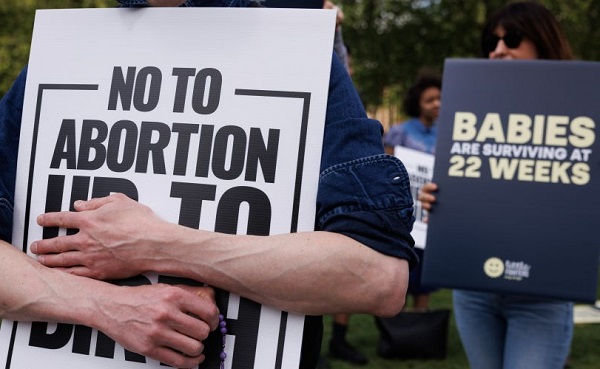Aristotle Foundation
At Toronto Metropolitan University medical school, some students are more equal than others


READ THE REALITY CHECK
By Bruce Pardy
A new Aristotle Foundation Reality Check from Queen’s University law professor Bruce Pardy details how Canada’s courts reinterpreted even the clear equality clause in the constitution to read in anti-individual “equity.” That hollowed out a founding Canadian principle of equality before the law.
|
|
|
Aristotle Foundation
B.C. Supreme Court takes an axe to private property rights

Native rights are constitutionally guaranteed; property rights are not. When courts recognize Aboriginal title, it’s easy to see who will win
Think you own your private property? Well think again, as a recent court decision has thrown the entire basis of property ownership into chaos in British Columbia.
In the ultimate “land acknowledgement,” the B.C. Supreme Court released a bombshell judgment last week declaring Aboriginal title for the Cowichan Tribes of Vancouver Island to around 325 hectares on the mainland, in the city of Richmond.
This is the first time a court has declared Aboriginal title over private land in the province, setting a deeply concerning precedent if the ruling is not successfully overturned following an appeal promised by B.C.’s attorney general.
In another troubling precedent, the court also declared that fee simple land titles — the typical form of private property ownership in Canada — in the area are “defective and invalid,” on the basis that the Crown had no authority to issue them in the first place.
As constitutional law professor Dwight Newman points out, if past fee simple grants in areas of Aboriginal title claims are inherently invalid, “then the judgment has a much broader implication that any privately owned lands in B.C. may be subject to being overridden by Aboriginal title.”
The only thing preventing the judge from making a similar declaration over privately held land in the new Aboriginal title area is the fact that the Cowichan did not ask for a declaration to this effect.
But nothing prevents that from happening in the future if the judgment stands. The judge actually contemplates this very scenario, writing that, “Fee simple interests … will go unaffected in practice when Aboriginal title is recognized over that land, unless or until the Aboriginal title holder successfully takes remedial action in respect of the fee simple interests.”
In short, while most private landowners assume their title to their own land is bulletproof, the ruling states: It “cannot be said that a registered owner’s title under the (Land Title Act) is conclusive evidence that the registered owner is indefeasibly entitled to that land as against Aboriginal title holders and claimants.”
It’s worth noting that the claim was contested by two mainland Indigenous groups, the Musqueam and Tsawwassen First Nations, both of whom lay claim to the same land. This highlights the issue of competing claims in a province where the vast majority of the land mass is claimed as traditional territory by one or more of B.C.’s 200-plus Indigenous groups.
While two previous decisions by the Supreme Court of Canada recognized Aboriginal title in British Columbia (Tsilhqot’in in 2014 and Nuchatlaht in 2024), neither declared it over privately held lands as this one does.
Even as the B.C. government has promised to appeal the decision, it has been pursuing similar policies outside the courts. The province controversially overlaid Aboriginal title on private land with its problematic Haida Nation Recognition Act in 2024. The act was specifically referenced by the plaintiffs in the Cowichan case, and the judge agreed that it illustrated how Aboriginal title and fee simple can “coexist.”
This is a questionable assertion given the numerous legal concerns. As one analysis explains, private property interests and the implementation of Aboriginal title are ultimately at odds: “The rights in land which flow from both a fee simple interest and Aboriginal title interest … include exclusive rights to use, occupy and manage lands. The two interests are fundamentally irreconcilable over the same piece of land.”
While the government claims it adequately protected private property rights in the Haida agreement, Aboriginal title is protected under the Constitution, while private property rights are not. When these competing interests are inevitably brought before the courts, it’s easy to imagine which one will prevail.
The fact that B.C. Premier David Eby said last year that he intended to use the Haida agreement as a “template” for other areas of B.C. stands in marked contrast with his sudden interest in an appeal as a means of preserving clear private property titles in the wake of this politically toxic ruling.
Indeed, Eby’s government continues to negotiate similar agreements elsewhere, including with the shíshálh Nation on B.C.’s Sunshine Coast, even as government documents admit that Aboriginal title includes the right to “exclusively use and occupy the land.”
Eby’s commitment to an appeal suggests he may have learned from his costly refusal to appeal a 2021 B.C. Supreme Court decision, which found that excessive development had breached the treaty rights of the Blueberry River First Nation. Eby’s government chose to pay out a $350-million settlement to avoid further litigation, a move that ultimately backfired when the two parties ended up back in court.
But for now, the consequences of the Cowichan decision have created considerable uncertainty for property owners, businesses and general market confidence. The judge’s own words sum it up: “The question of what remains of Aboriginal title after the granting of fee simple title to the same lands should be reversed. The proper question is: what remains of fee simple title after Aboriginal title is recognized in the same lands?”
If there’s one positive aspect to this decision, it’s that it is so extreme, it will force the Eby government’s radical Indigenous policies onto the public agenda as awareness builds over what’s at stake.
From its incessant land acknowledgements, to MLAs referring to non-Indigenous British Columbians as “uninvited guests,” to its embrace of the United Nations Declaration on the Rights of Indigenous Peoples and its land back policies, to undemocratic land use planning processes and the overlaying of Aboriginal title on private lands, B.C. government policy has long been headed in exactly this direction.
Now, a reckoning is coming, and it’s of the government’s own creation. The broader issue will soon overtake all others in the public eye, and the premier must decide now whether he’ll start walking things back, or double down on his disastrous course.
Caroline Elliott is a senior fellow with the Aristotle Foundation for Public Policy and sits on the board of B.C.’s Public Land Use Society.
Photo: WikiCommons.
Aristotle Foundation
Judges should interpret law—not make public policy from the bench

By Bronwyn Eyre
To understand how politicized Canada’s courts have become, one must understand how judges once viewed their role—not as policymakers, but interpreters of laws and the Constitution.
In 1982, the late Supreme Court of Canada Chief Justice Bora Laskin said judges have “no freedom of speech to address political issues that have nothing to do with judicial duties… Absolute abstention from political activity is one of the guarantees of impartiality, integrity and independence.”
That was then. Post-Charter (also introduced in 1982), too many judges have internalized the “living tree doctrine”—that the Constitution continually adapts to “evolving” social and political contexts—and are increasingly advancing expansive positions based on political ideology.
The result is that governments, elected to pass legislation, are unable to tackle important issues from homelessness to climate policy without being overruled by the courts. They are spending millions fighting Charter challenges—often brought by only a handful of complainants.
Just recently, Ontario’s Superior Court sided with just two University of Toronto students to stop the provincial government from dismantling bike lanes to ease traffic congestion. Under the Charter’s Section 7 (Life, Liberty, and Security of the Person), the government cannot, ruled the court, “knowingly make the streets less safe.” Talk about begging the question. Meanwhile, an effort by the Ontario government to dismantle drug injection sites, including near schools and daycares, is on pause pending another Section 7 legal challenge.
In another case with major precedent impact across the country, Ontario’s Superior Court held in 2023 that homeless encampments must effectively remain in place until shelter spaces are found for every resident. The City of Waterloo’s attempt, via municipal bylaw, to dismantle a 70-structure homeless encampment on city property was held to violate—once again—Section 7 of the Charter. Stated the court: “The constitutional right to shelter is invoked when the number of homeless exceeds available and truly accessible shelter spaces.”
The same court agreed in 2023 with just seven environmental activists challenging Ontario’s climate plan that it is an “indisputable fact that Ontarians are experiencing an increased risk of death” from climate change.
According to Ecojustice lawyer Fraser Thomson, who represented the activists, the ruling “effectively boxes Ontario in and subjects its climate record to full Charter scrutiny.” The Supreme Court recently denied Ontario’s appeal request in the case, which is now heading back to court. This, as similar youth-led climate cases are making their way through the courts in other provinces.
Meanwhile, last month’s International Court of Justice’s ruling that a clean environment is a “human right” was hailed by climate activists as a major victory which will inform future court decisions and legal challenges—including to the new federal major projects Bill C-5.
Courts ought not be the exclusive arbiters of social and economic policy—genuine concerns about issues such as climate policy or homelessness, notwithstanding.
So, what to do?
For now, premiers are increasingly looking to the Notwithstanding Clause. Routinely called the “nuclear option,” it’s actually a perfectly legitimate use of Section 33 of the Charter—and the most powerful tool governments have to assert parliamentary sovereignty.
A constitutional scholar and former NDP premier of Saskatchewan, Allan Blakeney, would agree. Blakeney fought hard for the clause’s inclusion in the Charter and wrote, in 2010, that the state could invoke it for “economic or social reasons, or because other rights are more important.”
Let’s not forget that from 1982 to 1985, Quebec “notwithstood” everything—and that doesn’t mean one must agree with its every usage. The point, à la Blakeney, is that it is the only mechanism to reassert some parliamentary supremacy. More recently, Quebec and Alberta have talked about forming an “autonomy alliance,” which would create a “special deliberation mechanism for legislative bills and include the Notwithstanding Clause to dissuade court challenges.”
If only such a mechanism could reform federal catch-and-release laws.
In 2023, Justice Harrison Arrell released violent offender Randall McKenzie, citing Criminal Code-embedded bail rules that mandate “vulnerable population” considerations. “It’s a very iffy case,” Arrell wrote. “I appreciate all the violence in his record, but part of that is his native background, education and employment opportunities.”
Six months later, McKenzie killed OPP Constable Greg Pierzchala. The shocking case highlighted 2018 federal Criminal Code amendments, which codified the “principle of restraint”—that bail must be granted at the “earliest possible opportunity” on the “least onerous conditions.”
Despite limited subsequent tweaks to the Criminal Code by the federal government, nothing fundamentally has changed.
When asked whether Canada is “soft on crime,” Sean Fraser, Canada’s new minister of justice and attorney general, said we “can’t operate in the space of slogans and soundbites.”
Indeed.
Hon. Bronwyn Eyre, LLB, is a Senior Fellow with the Aristotle Foundation for Public Policy, Saskatchewan’s former minister of justice and attorney general—the first female to hold each position—and a former long-serving minister of energy.
Photo: iStock.
-

 Censorship Industrial Complex2 days ago
Censorship Industrial Complex2 days agoCanada To Revive Online Censorship Targeting “Harmful” Content, “Hate” Speech, and Deepfakes
-

 International2 days ago
International2 days agoTrump, Netanyahu inch closer to peace plan for Gaza
-

 Alberta2 days ago
Alberta2 days agoAlberta refuses to take part in Canadian government’s gun buyback program
-

 Business1 day ago
Business1 day agoTaxpayers deserve proof of how politicians spend their money
-

 Business1 day ago
Business1 day agoOttawa’s civil service needs a Chrétien-style reset
-

 Alberta2 days ago
Alberta2 days agoOrthodox church burns to the ground in another suspected arson in Alberta
-

 Fraser Institute1 day ago
Fraser Institute1 day agoAboriginal rights now more constitutionally powerful than any Charter right
-

 Alberta1 day ago
Alberta1 day ago$150 a week from the Province to help families with students 12 and under if teachers go on strike next week









